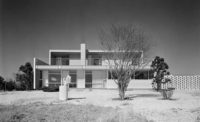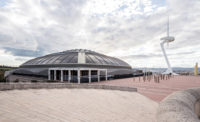“Architecture is not about things, it is about people and life,” John Portman said to the dean of the Graduate School of Design at Harvard, Mohsen Mostafavi, in a wide-ranging interview that starts off the provocative book Portman’s America & Other Speculations, published last year by Lars Muller. Portman’s words are not notable in themselves—they are the kind of clichéd line almost every architect has uttered at one time or another. What makes them striking is how passionately Portman believed them, and how much he managed to do in his long career to turn this line from a banal observation into a kind of architectural talisman, a defining byword for what he would build.

Photo © 2014 PWP Studios, courtesy of The Portman Archives, LLC.
Portman, who died on December 29 in Atlanta at the age of 93, was like no other figure in American architecture. For most of his career he was an outsider to the academic architecture establishment, which came to embrace him only toward the end of his life when, like Morris Lapidus, his flamboyant work could be analyzed as a cultural marker rather than feared as a disrupter. But he was every bit as much an outsider to the corporate architecture establishment, to the vast architecture and engineering firms that churn out mediocre office towers, hotels, airports, and shopping malls and make the average person believe that modern architecture has neither heart nor soul. Portman broke the model of the corporate developer hiring the corporate architect by being both of those things himself. As a developer, he bought himself the freedom to build what he wanted, which was as far from the architecture of the freeway as it was from the architecture of the salon.
It was an architecture of futuristic fantasy, based on some simple ideas: that people liked big, open interior space, movement, light, color, and texture; that they liked simple geometric forms, which could be twisted and torqued in all kinds of ways; and that they could be induced to spend time in cities if the buildings they found there excited and did not repel them. And so we had Portman’s breakthrough building, the Hyatt Regency in Atlanta (1967), the first modern atrium hotel, which demonstrated better than any building of the 1960s that people were ready to accept architecture as entertainment if architects would give them structural drama with lively, eye-catching details.
Portman’s earnestness, and his curiosity, were relentless. Nothing underscored how different he and his firm were from a large corporate practice as much as his refusal to turn the Atlanta Hyatt Regency into a simple formula. Others produced bad copies of it, while Portman himself kept trying to vary it, most successfully in San Francisco, where the Embarcadero Hyatt (1973) remains one of his finest buildings. He had devised another variation at the O’Hare Airport in Chicago (1969) and would produce yet another at the Marriott Marquis in New York (1985), where the atrium grew in scale but not, alas, in quality; and at the Atlanta Marriott (1985), where he managed to produce a much bigger atrium that was a triumph of complex, torqued form.
At O’Hare, Portman placed four round glass cylinders at the corners of a concrete building with an atrium that was based roughly on the original in Atlanta, and as he moved through the 1970s, he became all the more interested in creating compositions of cylinders. Out of this came, first, the tall, slender cylinder of the Westin hotel in Atlanta, at the time of its completion in 1976 the tallest hotel in the world, and then two of his most famous projects, Renaissance Center—now the headquarters of General Motors—in Detroit (1977), and the Westin Bonaventure Hotel in Los Angeles (1976), all three of which revealed, far more than his earlier work for Hyatt, Portman’s Achilles heels as a designer: that once his buildings began to get complicated his plans were highly confusing, not to say disorienting; and that he had absolutely no interest in the street. Portman genuinely loved cities and wanted to see them flourish, but his notion of urbanism was all interior. He envisioned his buildings as hives of social activity, but he wanted the energy to be all self-generated within, and he was never comfortable with any degree of porosity between his buildings and the city beyond.
Back in the 1970s, you could almost get away with that, since the general view of cities was that they were messy, dirty, and dangerous. By investing in downtowns and trying to use his architecture to stimulate social life, Portman believed he was supporting the city. Compared to developers who decamped for the suburbs, he was. But he failed to understand the extent to which both ordinary and great urban architecture needs to connect to the street, not turn away from it. Portman always admired Rockefeller Center, which he felt was a model for Peachtree Center, his slender skyscraper grouping in Atlanta of which the Hyatt Regency was a part, and its West Coast sibling, the Embarcadero Center in San Francisco. But he either didn’t see, or care, that much of the genius of Rockefeller Center’s design is in its connection to the Manhattan street grid.
Portman’s indifference to the street, and his belief that his architecture—big and muscular outside, more playful inside—would ignite urban life by itself was endemic of the 1970s, which is surely why many of his buildings, for all their failings, are enjoying a new popularity. They are part of history, and to 21st century eyes there is something exotic about them now, a vision of the future that is simultaneously audacious and quaint. Not for nothing are Portman’s hotels staples of the movies, from Mel Brooks’s High Anxiety to John Carpenter’s Escape from L.A. Portman was entranced with the power of big, bold space and big, bold form to make life interesting. And for a long time, that is exactly what his buildings have done.











Post a comment to this article
Report Abusive Comment